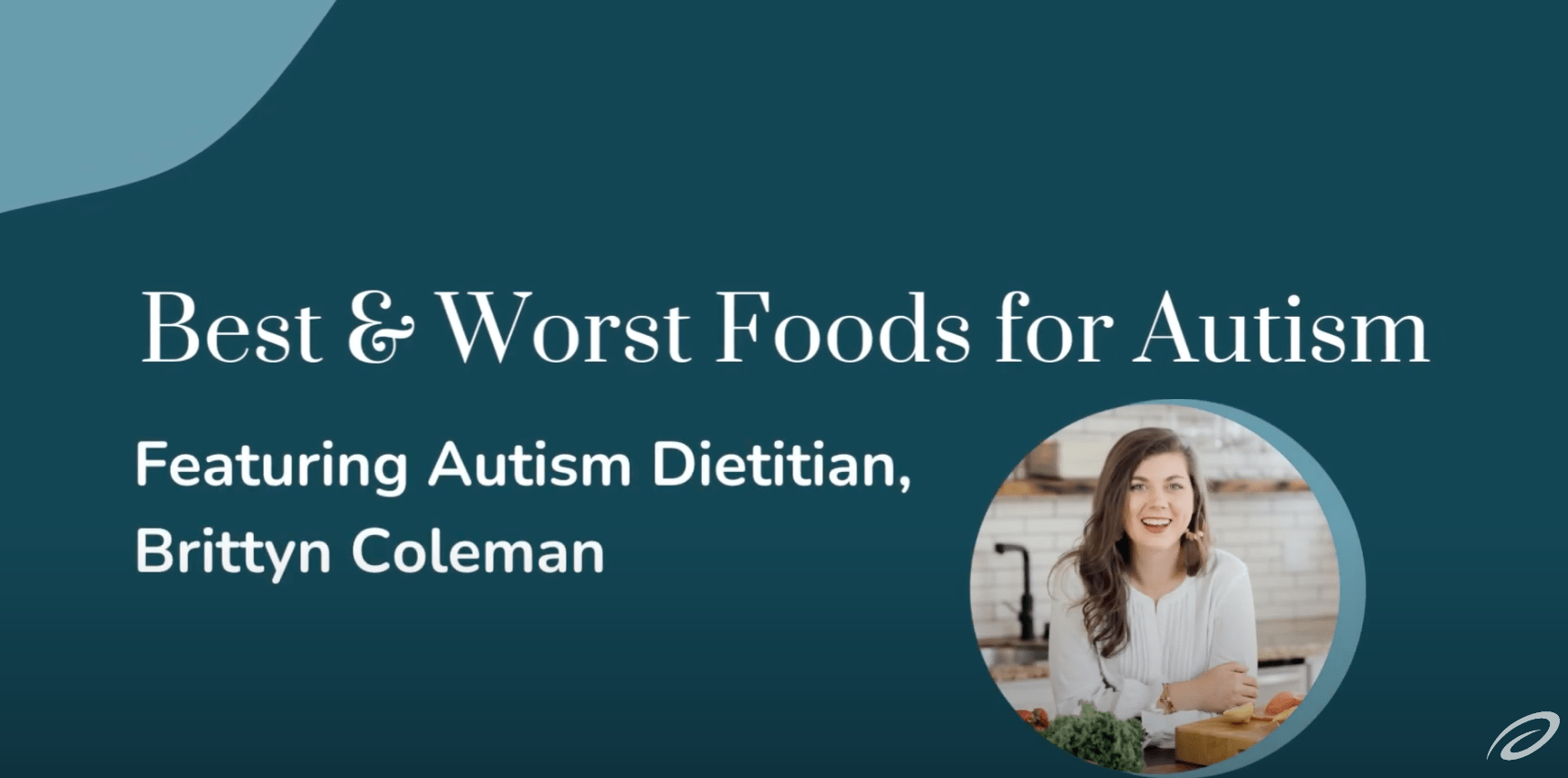In a culture that deems “kid foods” dishes that are highly processed, fried, and packed with artificial colors & preservatives - it’s no wonder that more than half of children in the United States have diets that are poor in quality.
Every 1 in 36 children in the United States is diagnosed with autism spectrum disorder (ASD), a condition that can make dietary changes even more difficult. Sensory sensitivity is common in children with autism, which can cause them to refuse more foods and eat fewer vegetables than those without sensory sensitivity. Additionally, gastrointestinal symptoms, oral motor issues, nutrient deficiencies, and medication interactions are all variables that often affect nutrition for kids on the autism spectrum.
Find out what foods are best for your child with autism and get helpful tips from Registered Dietician who specializes in ASD, Brittyn Coleman, MS, RDN / LD, CLT.
Autism & Unbalanced Diet
Individuals on the autism spectrum often have an unbalanced diet or require a special diet that may affect nutritional intake. This can be caused by:
- Food aversions due to sensory sensitivity that may decrease the variety or number of foods in their repertoire.
Check Your Eligibility
In 2 easy steps!
Discover the bladder control supplies covered by your Medicaid plan.
- Chronic gastrointestinal issues (commonly constipation) that may impact appetite or decrease absorption of key nutrients from the diet.
- Food sensitivities or food allergies that may further limit their variety of foods and decrease nutrient intake.
- Low muscle tone (hypotonia) that affects the ability to chew and swallow certain foods.
- Certain medications that may increase or decrease both appetite and metabolism.
What Does the Research Say?
There is a wide range of research studies highlighting the importance of nutrition for autism and clear gaps needing intervention. Individuals on the autism spectrum are more likely to:
- Exhibit higher rates of severe picky eating and severe resistance to new foods, as well as higher rates of reported constipation.
- More likely to have an unhealthy body weight.
- Lower levels of physical activity and higher levels of sedentary behavior.
- Experience significantly more general gastrointestinal symptoms.
- Have imbalances in their gut microbiome, which may influence development and severity of symptoms.
- Consume a diet at risk for 5 or more nutritional inadequacies.
- Have digestive issues including low digestive enzyme activity, impaired gut barrier integrity, and food sensitivities.
- Become overweight or experience obesity due to a decrease in physical activity and an increase in certain eating habits.
- Prefer calorie-and-carbohydrate-dense junk food that has high sodium levels and less nutritional value.
- Experience leaky gut.
- Have imbalanced blood sugar levels, possibly due to ADHD/ASD overlap.
- Have restricted diets due to food selectivity or food aversion, aka “picky eaters.”
- Have a weaker immune system due to hypersensitivity, autoimmunity, or inflammation.
- Have increased nutritional needs based on low levels of iron, zinc, calcium, fiber, folic acid, and vitamins A, C, D, E, K, B6, and B12.
The Best Autism Diet
While there is no “one-size-fits-all” diet for autism, there are certain diets, supplements, and foods that may have positive side effects.
1. A well-balanced diet. A balanced diet with emphasis on lean proteins, healthy fats, and fibrous foods (fruits, vegetables, and whole grains) can be incredibly beneficial for those on the autism spectrum to support gut health and brain development.
2. The Gluten-Free diet & Casein-Free diet (GFCF diets). This diet is common in the autism community. The strongest link between foods and ASD consists of wheat and dairy products. The evidence is mixed, though these diets may be beneficial for a specific subset of children on the spectrum, especially those with gastrointestinal issues. This is because it can be hard for a child’s gut enzymes to break down wheat and dairy.
3. Supplements. Multivitamins, probiotics, and essential fatty acid supplements can help fill in nutritional gaps from a limited diet and replete any nutrient deficiencies.
Good Foods for Autism
While there is no “one food” that is best for an individual on the autism spectrum, consuming a wide variety of foods and food groups can help improve nutritional intake and prevent nutrient deficiencies, such as zinc and Vitamin D. We recommend including the following foods in your child’s diet:
- High quality proteins such as pastured chicken and eggs, grass-fed beef, and wild-caught salmon.
- A variety of fresh fruits or frozen fruits and vegetables.
- Whole grains like oats, brown rice, and quinoa.
- Foods rich in omega-3 fatty acids including nuts, seeds, and fish.
- Beans and legumes.
Foods That Can Make Autism Symptoms Worse
Children on the autism spectrum are at higher likelihood for food sensitivities and gut bacteria imbalances, which suggest certain foods may be best avoided, including:
- Highly refined or processed foods.
- Artificial ingredients (colors, sweeteners, and preservatives).
- Gluten (the protein in wheat, barley, and rye).
- Casein (the protein in milk).
- Corn or soy.
- Pesticides (choose organic produce instead).
Always keep allergies in mind when trying new foods. Talk to a dietitian or nutritionist if you think you might be allergic to certain foods.
Snack Ideas
Children should be eating every 2-3 hours, so having balanced meals and snacks is important! Here are a few quick snack ideas that you can prepare ahead of time or throw in your child’s bag for a nourishing snack between school and therapies:
- Individual trail mix packets.
- Almond flour crackers with almond butter.
- Turkey jerky stick with fruit leather.
- Protein bars.
- Peanut butter filled pretzels.
Tips to Help Along the Way
Adjusting to a new diet or trying new foods may be difficult for those on the autism spectrum, especially if they experience food aversions. Here are a few tips to help make the transition as easy as possible:
- Consider your child’s current preferred foods. Consider what texture, color, or temperature their foods are. Consider offering new foods that are similar to their favorite foods to help them feel more at ease
- Remember that “eating” is not the only food win! Having a new food on the plate, touching it with a fork, smelling it, and even chewing and spitting are all great wins! Taking it one step at a time will help it feel less overwhelming. Also keep in mind that autistic children and adolescents can take longer to adjust to dietary intervention.
- Don’t force a child to eat a food before they’re ready or remove their favorite foods in an attempt for them to eat healthier foods “when they are hungry." Sensory issues do not resolve with hunger and this approach may cause more harm than good.
- Work alongside a dietitian who specializes in autism to help provide accountability and creative ways to expand your child’s diet.
Stay in touch with your healthcare provider or dietician during the process of introducing new foods in case the new meals cause gastrointestinal issues or other behavior-related changes.
Only you, your child, and a healthcare provider or dietician can decide what diet is right for your child’s dietary needs. Be sure to talk to a healthcare professional about your diet before making any changes.
How to Get Free Incontinence Products Through Medicaid
Sometimes when we experiment with new diets, it can have a certain reaction inside our bodies. If you or your child experiences incontinence, Aeroflow Urology can help. We assist in supplying incontinence supplies for children and adults through Medicaid (and some private insurance) plans.
If you'd like to find out if you qualify to receive incontinence care products through your insurance, simply fill out our secure Eligibility Form. From there, one of our Continence Care Specialists will take care of everything.
If approved, we'll help you find the exact products you or your child needs. Each month, your supplies will be sent directly to your door in discreet packaging. We will send you a text message or email reminder when it's time to fill up on supplies each month, so you'll never have to go to the store for incontinence supplies again!
Liu, J., Rehm, C. D., Onopa, J., & Mozaffarian, D. (2020). Trends in Diet Quality Among Youth in the United States, 1999-2016. JAMA, 323(12), 1161. https://doi.org/10.1001/jama.2020.0878
Centers for Disease Control and Prevention. (2021, December 2). Data & statistics on autism spectrum disorder. Centers for Disease Control and Prevention. https://www.cdc.gov/ncbddd/autism/data.html
Chistol, L. T., Bandini, L. G., Must, A., Phillips, S., Cermak, S. A., & Curtin, C. (2017). Sensory Sensitivity and Food Selectivity in Children with Autism Spectrum Disorder. Journal of Autism and Developmental Disorders, 48(2), 583–591. https://doi.org/10.1007/s10803-017-3340-9
Liu, X., Liu, J., Xiong, X., Yang, T., Hou, N., Liang, X., Chen, J., Cheng, Q., & Li, T. (2016). Correlation between Nutrition and Symptoms: Nutritional Survey of Children with Autism Spectrum Disorder in Chongqing, China. Nutrients, 8(5), 294. https://doi.org/10.3390/nu8050294
Li, Y., Xie, X., Lei, X., Li, Y., & Lei, X. (2020). Global prevalence of obesity, overweight and underweight in children, adolescents and adults with autism spectrum disorder, attention‐deficit hyperactivity disorder: A systematic review and meta‐analysis. Obesity Reviews. https://doi.org/10.1111/obr.13123
Jones, R. A., Downing, K., Rinehart, N. J., Barnett, L. M., May, T., McGillivray, J. A., Papadopoulos, N. V., Skouteris, H., Timperio, A., & Hinkley, T. (2017). Physical activity, sedentary behavior and their correlates in children with Autism Spectrum Disorder: A systematic review. PLOS ONE, 12(2), e0172482. https://doi.org/10.1371/journal.pone.0172482
McElhanon, B. O., McCracken, C., Karpen, S., & Sharp, W. G. (2014). Gastrointestinal Symptoms in Autism Spectrum Disorder: A Meta-analysis. PEDIATRICS, 133(5), 872–883. https://doi.org/10.1542/peds.2013-3995
Iglesias-Vázquez, L., Van Ginkel Riba, G., Arija, V., & Canals, J. (2020). Composition of Gut Microbiota in Children with Autism Spectrum Disorder: A Systematic Review and Meta-Analysis. Nutrients, 12(3), 792. https://doi.org/10.3390/nu12030792
Sharp, W. G., Postorino, V., McCracken, C. E., Berry, R. C., Criado, K. K., Burrell, T. L., & Scahill, L. (2018). Dietary Intake, Nutrient Status, and Growth Parameters in Children with Autism Spectrum Disorder and Severe Food Selectivity: An Electronic Medical Record Review. Journal of the Academy of Nutrition and Dietetics, 118(10), 1943–1950. https://doi.org/10.1016/j.jand.2018.05.005
Saad, K., Eltayeb, A. A., Mohamad, I. L., Al-Atram, A. A., Elserogy, Y., Bjørklund, G., El-Houfey, A. A., & Nicholson, B. (2015). A Randomized, Placebo-controlled Trial of Digestive Enzymes in Children with Autism Spectrum Disorders. Clinical Psychopharmacology and Neuroscience, 13(2), 188–193. https://doi.org/10.9758/cpn.2015.13.2.188
Sanctuary, M. R., Kain, J. N., Angkustsiri, K., & German, J. B. (2018). Dietary Considerations in Autism Spectrum Disorders: The Potential Role of Protein Digestion and Microbial Putrefaction in the Gut-Brain Axis. Frontiers in Nutrition, 5. https://doi.org/10.3389/fnut.2018.00040
Doreswamy, S., Bashir, A., Guarecuco, J. E., Lahori, S., Baig, A., Narra, L. R., Patel, P., & Heindl, S. E. (2020). Effects of Diet, Nutrition, and Exercise in Children With Autism and Autism Spectrum Disorder: A Literature Review. Cureus, 12(12). https://doi.org/10.7759/cureus.12222
Autism - Food for the Brain. (n.d.). Food for the Brain. https://foodforthebrain.org/condition/autism/
Hyman, S. L., Stewart, P. A., Schmidt, B., Cain, U., Lemcke, N., Foley, J. T., Peck, R., Clemons, T., Reynolds, A., Johnson, C., Handen, B., James, S. J., Courtney, P. M., Molloy, C., & Ng, P. K. (2012). Nutrient Intake From Food in Children With Autism. Pediatrics, 130(Supplement 2), S145–S153. https://doi.org/10.1542/peds.2012-0900l
Ly, V., Bottelier, M., Hoekstra, P. J., Arias Vasquez, A., Buitelaar, J. K., & Rommelse, N. N. (2017). Elimination diets’ efficacy and mechanisms in attention deficit hyperactivity disorder and autism spectrum disorder. European Child & Adolescent Psychiatry, 26(9), 1067–1079. https://doi.org/10.1007/s00787-017-0959-1
Information provided on the Aeroflow Urology website is not intended as a substitute for medical advice or care from a healthcare professional. Aeroflow recommends consulting your healthcare provider if you are experiencing medical issues relating to incontinence.










